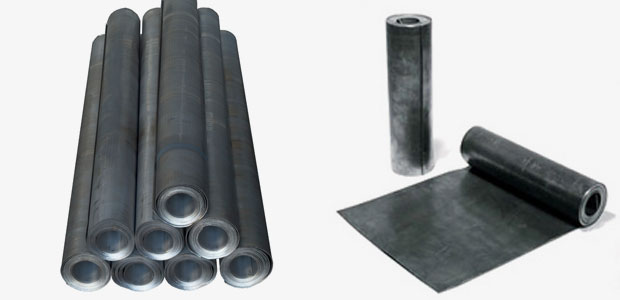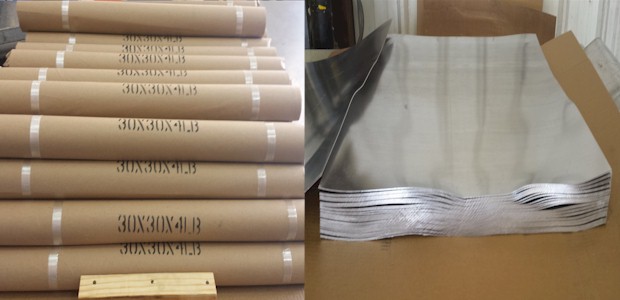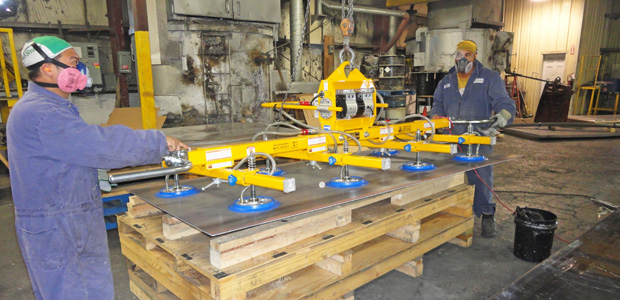Information Sheet Safety Data Sheet
Over 70 tons of sheet lead in stock in various sizes are available for quick turnaround at our warehouse! Our high quality Sheet Lead is manufactured from pure lead conforming to ASTM B-29, B-749 and Federal QQ-L-201F, QQ-L-171E.
Mars Metal offers sheet lead as laminated panels, adhesive bonded to such materials like plywood, gypsum board, and other supporting materials. Since sheet lead has very little inherent structural strength, most applications require that the sheet lead be supported in some fashion, or that the sheet lead be laminated to provide a more rigid building material. Mars Metal offers quick turnaround time on all sheet lead. With our large inventory of sheet lead most orders can be shipped out on the same day.
We offer in house Precision 3D and CNC Machining of sheet lead. Learn More.
With our large inventory of sheet lead most orders can be shipped out on the same day. These sizes are available for immediate shipping …
- 1/32″ x 48″ x 96″
- 1/32″ x 48″ x 120″
- 1/16″ x 48″ x 96″
- 1/16″ x 48″ x 120″
- 1/8″ x 48″ x 96″
- 1/8″ x 48″ x 120″
- 1/4″ x 48″ x 60″
Mars Metal offers sheet lead for many applications that include:
- Radiation Shielding – Laboratories, Hospitals, Dental Offices and Veterinary Clinics
- Construction – Roofing, Flashing and Waterproofing
- Corrosion Protection – Acid Storage and Handling – Autoclaves – Precipitators
- Movable Lead Screens
- Sound Barriers and Sound Proofing
- Nuclear Energy Shielding
- Tank Lining
- Vibration Absorbers
If you are looking for sheet lead for radiation protection please visit our MarShield website.
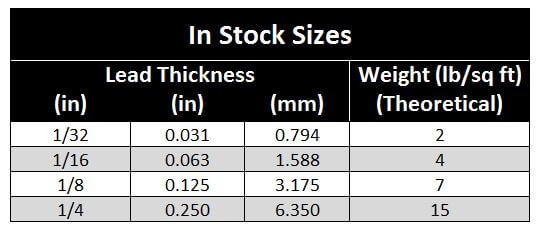
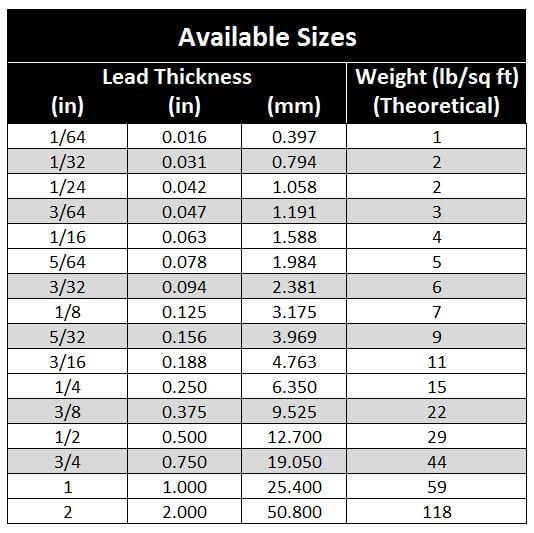
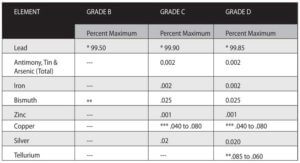
** When specified , the bismuth content of grade B shall be 0.025 percent maximum.
*** Range For grades C and D, no element other than those specified shall exceed 0.001 percent maximum as determined by a normal spectrographic analysis
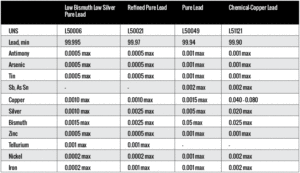
The Versatility of Sheet Lead and Its Uses
Sheet lead possesses many benefits that make it highly desirable in a variety of applications. Lead is a very soft metal that can be easily formed and cut to size by hand at room temperatures without work hardening. Lead is a nonferrous metal so it does not rust and its inherent density coupled with its high limpness value give it many uses in industry. Sheet lead is highly resistant to corrosion so it is a desirable product to use for tank linings for corrosive acids and strong industrial chemicals and corrosion resistant sealing gaskets. It is equally practical for use in salt water applications and is very good for roofing applications where it resists the effects of acid rain. Its high limpness value and its consistent density make it a very good sound damper and very effective at isolating vibration. It is waterproof and is often used as the waterproof barrier beneath fountains, reflecting pools and even shower stall bases.
Sheet Lead Installation Guidelines
Mars Metal recommends the use of Sheet Lead that is factory bonded to drywall/gypsum board, lath, or plywood for wall covering. This allows the lead to remain rigid and flat during the installation and insures a continuous meeting edge if installed correctly. Where Sheet Lead must be used on its own then the following guidelines may be used.
Certain criteria must be considered for the coverage to each wall or surface that meets the site physicist’s recommendations.
- Lead thickness or lead equivalency specified
- Total area of coverage, walls, ceiling and floor
- Coverage height up walls
- Doors, windows, frame and electrical outlet or switches
- Safe Lead handling and installing at site
Appropriate Sheet Lead Sizes are as follows:
- 2 LB Per Square Foot or 1/32” thick lead
- 4 LB Per Square Foot or 1/16” thick lead
- 8 LB Per Square Foot or 1/8” thick lead
16 LB Per Square foot or ¼” thick lead is not recommended due to the heavy weights while handling. It is much easier to use multiple layers of a smaller size of sheet lead than anything over 8 LB or 1/8” thick.
For 1/32” thick Sheet Lead and up to 1/16” thick, overlap all joints by 1”. For Lead over 1/16” thick, apply a 2” wide batten strip at each vertical joint, fastening at top and bottom as required and/or down each edge of wooden or metal stud. We recommend you leave a minimum of 1” width of the lead batten strip without fasteners.
Place Sheet Lead against wall studs to recommend height above the floor and then securely fastened the top portion of the lead sheet to the studs with proper fasteners. Butt all Lead Sheets together at each joint for lead over 1/16” thick, then fastened sheets down to studs. Where multiple layers might be used it is recommended that you stagger all joints between the layers. Cover all fasteners that have pierced the sheet lead with Lead Tabs/disks or buttons of equal lead thickness and glue them in place with a construction adhesive. You may find where the lead overlaps or where the lead battens are placed creates a high spot. It is recommended that these areas be shimmed at the non-joint studs to insure a level wall surface prior to adding final wall coverings materials such drywall/gypsum board or plywood.
Where built-in-items penetrate lead linings, provide lead shields behind those cut-outs as required to maintain continuity of radiation protection. Where outlet boxes, junction boxes, ducts, conduit, and similar items prevent use of shields, provide sheet lead sleeves or linings as required.
Note: Wherever sheet lead is cut, pierced or penetrated for any reason, assure it I rectified by use of same thickness sheet lead, plug or other desired and approved methods.
Installation Guidelines for Lead Lining in Floors
In certain situations, the floor and/or ceiling of your room may require radiation shielding. Mars Metal recommends whenever possible laying the Sheet Lead in the floor before the finished floor is poured. All joints should have a minimum of one inch overlap if multiple pieces are to be used. Overlap at each joints between piece or apply 2” wide lead strip batten at each joint and glue in place. If multiple layers are to be used, stagger all joint between layers. Ensure your sheet lead selection allows for safe & easy handling at the site and be sure to verify floor-loading limits are adequate with the architect. The Sheet Lead should extend up each wall a minimum of two inches. Additional concrete can be applied over the lead finishing.
Lay the Sheet Lead directly over existing concrete floor then coat fully cured concrete with a sealant like varnish to prevent chemical interaction between the concrete and lead and let the sealant or varnish fully dry. Ensure the lead is free of bumps, air pockets or obstructions and lies completely flat. It is recommended before securing lead to floor that a small sample area be done first to ensure adhesion with the varnish or sealant coating. Use a construction adhesive on hard to secure spots or areas. Pres or roll the sheet lead completely flat on the floor.
Prior to laying carpeting or tile covering we recommend applying an underlay sub floor consisting of a ¼” or heavier approved plywood or other firm solid material over the Sheet Lead. Fastened down the material with a good quality construction adhesive. Performing this extra step will help spread the floor loading over a wider area eliminating point loading that could deform the sheet lead below. Alternatively floor anchor bolts countersunk can be used if lead buttons are used of each anchor point.
The lead protection may be obtained in two ways. If possible, it is simplest to lay sheet Lead on top of the floor slab above, allowing it to extends out at least 8” in every direction beyond the lead walls below it.


